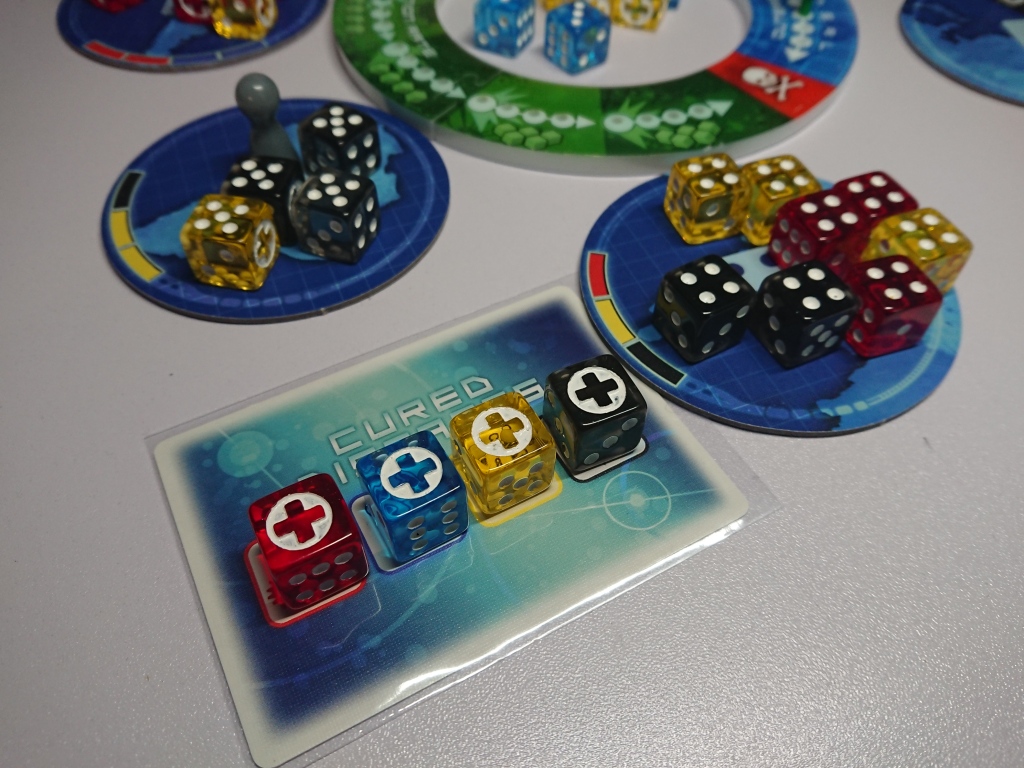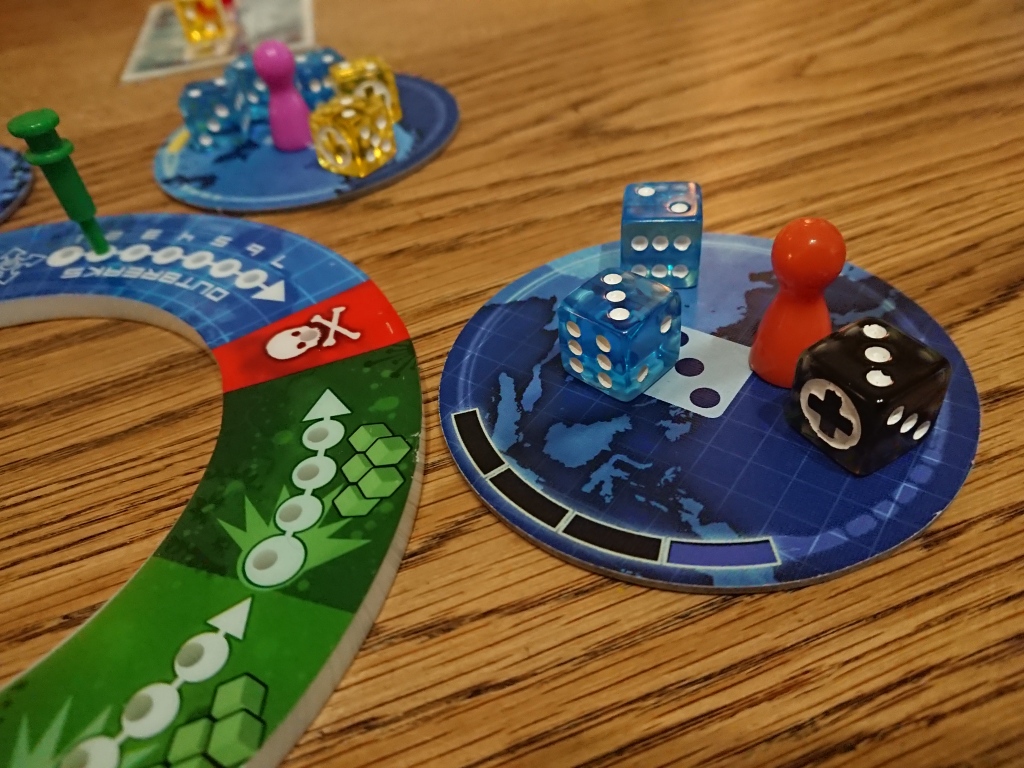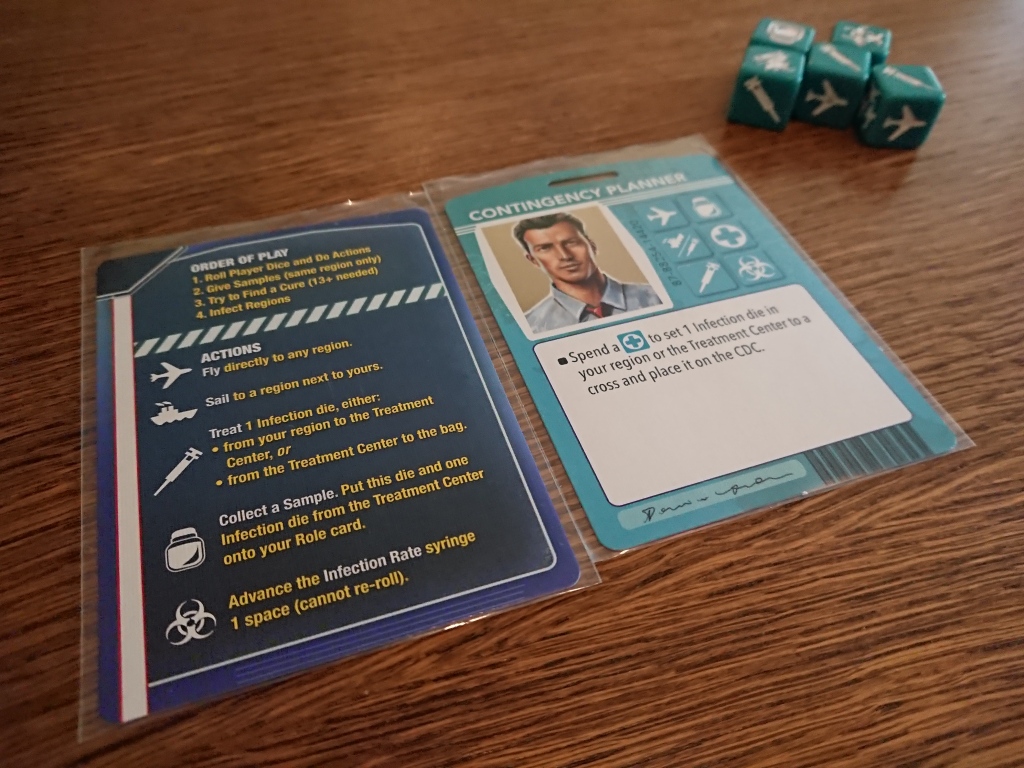For some reason I have still not quite got around to reviewing the original Pandemic, but, in a nutshell, it is one of the great original cooperative games in which players band together to attempt to beat the design itself, a concept that was entirely alien to me when I first got into the hobby in depth until I played…Pandemic. This game, ancient in cardboard terms yet still feeling fresh, in which characters traverse the globe managing outbreaks and seeking cures, has proven so robust and enduring that it has gone on to spawn an entire franchise of related products, from those that place the mechanisms of that first game in other historical and geographical settings to those that actually make the players into the disease attempting to wipe out humanity.
Normally one would expect Game X, if successful enough, to spawn Game X: The Card Game and Game X: The Dice Game, but, given that Pandemic is really a card game, here we only have the latter of the two variants, sweeping across the world under the name Pandemic: The Cure. A small thing, perhaps, but it is a title that I much prefer to the possibility of Pandemic: The Dice Game, even if the aim of the experience is essentially the same as in the original design – attempt to save the world from four diseases before they either overrun the entire population or time runs out.
The Cure arrives with a little bit of a twinkle in its eye, though, taking that post-colon part of its name and riffing on it just a touch, with the front of the box telling us that it is Fast Acting! and Extra Strength. It is a small detail, but engaging, and drops that little hint that care and attention has been paid to all aspects of the design, even the packaging.
Talking of care and attention, the role cards in Pandemic: The Cure are shaped like lanyards in the early editions, which happens to be the version I own, and is a lovely touch, though abandoned later on in the expansion, something I feel is a shame. Still, there they sit in the box alongside cards to represent the events, and buckets of dice – a whole pile of translucent six-siders in four colours to represent the various diseases, and a hefty selection of bespoke dice in addition for each role.
The fixed world map of the original game is represented here by six circular pieces of card – only six continents – which are laid out during set up around a large plastic ring which will be used to track outbreaks and infection rates via two small syringes (quality again) and also to contain dice that have been transferred to the treatment centre. Certain colours of dice will only infect certain areas of the map, a touch which will become progressively more important as players get used to how the game unfolds, and this information is printed on each of the separate continents.
The character dice are where the real meat of the game resides, though, and where in the original game each role had its own ability, here the differences between the disease-fighters are manifest in the results that they can roll. Some, such as the Medic, are strong on treatment symbols, others are better at taking the samples which are needed to find cures, while others simply refuse to travel by air, meaning that they can only move to adjacent continents on their turns. Still, there is something deeply and primally satisfying about grabbing those five (or seven, for one of the characters) dice and seeing what they come up with.
Unfortunately, something that is common to every single character die is the biohazard symbol, which, when rolled, causes the infection tracker to move up a notch. Move into a new area of infection and an epidemic breaks out; end up with four of the same coloured dice on one continent and you suffer an outbreak. Too many of these and it is game over, so managing the number of dice on the tiles while simultaneously attempting to find a cure, which involves gathering similar coloured dice and rolling a total of thirteen or more, is what the game is all about.
Turns are easy to grasp, and Pandemic: The Cure allows a player to reroll their dice as many times as they like until either they come up with a biohazard symbol (bad) or find a symbol that they can use (good), although sometimes you will end up with an unused die, which seems unutterably profligate in a game as pressing as this. Take your actions, which can include passing samples to other players on the same tile at the end of your turn, roll for a cure if you feel you can hit lucky thirteen or higher, and then grab some more dice from the infection bag and see where the latest breakouts have occurred.
Thankfully, rolling a cross on a disease die moves it to the CDC tile (Center for Disease Control), which means that it can be spent to activate an event, three of which are always face up on the table. A canny use of these at the right time can help to tip the odds in the right direction, and any help at all can be useful in this game.
It all seems pretty simple, but gathering samples also requires that players ‘lock’ them in with one of their character dice, limiting their options until they find a cure, so it can be easy to end up substantially weakened for long periods of time. A failed attempt at a cure locks those dice in for another turn, which can feel terribly expensive, so the pressure is on from the moment you collect your first sample.
The thing with dice in a game such as Pandemic: The Cure is that each roll of them is a separate and self-contained event, whereas drawing a card off the deck then removes that card from the pool of possibilities that remain to be drawn. Throw your character dice and you always have a one in six chance on each die of advancing the infection tracker, while in the original Pandemic you had a decent possibility that certain cities would not be infected in the current round. It seems really obvious but it needs to be said – Pandemic: The Cure has a whole jittery pile of six-sided randomness baked into its design, which means that two criteria need to be met in order for the design to be successful. Firstly, are there enough ways for players to mitigate the outer edges of the dice rolls, not necessarily enough to control results but certainly to smooth out the sharper outcomes? Secondly, is the game’s length short enough not to feel as though hours have been spent playing a design whose outcome is determined by a multi-coloured stack of randomness?
Thankfully the answer to both of those questions is yes, although with some qualifications. A game such as this would not be a game if it turned out to be beatable every single time it was played, so a balance needs to be struck between being able to dictate the outcomes of the dice and being able to nudge them in the right direction, and this is where the event cards come in, a selection of which may be purchased, at various costs, with infection dice which have decided to land with the benign aid symbol uppermost. These cards mirror many of those in the original game, such as One Quiet Night, but they also allow players to use abilities which offer them, for example, the chance to ignore a biohazard symbol or reroll a die when seeking a cure.
As for the length of the game, the various built-in timers – the dice themselves, the outbreak tracker and the infection rate – all serve to keep the hours from passing by, making sure that decisions need to be hemmed in by a sense of urgency while articulating that you are up against it even from the start, yes, even on Introductory level. At around half an hour per game The Cure feels just about right in terms of what it does.
It is also more different from the original Pandemic than those board-based versions which tend to tweak the formula rather than reimagine it from the ground up. Yes, the various modes of travel are here, the different coloured diseases, that rule about more than three causing an outbreak, but it definitely feels like its own thing. It nods towards Pandemic but has the wisdom not to ape it completely, instead going its own way, and it feels simultaneously lighter and more breezy as a result, though not when you are looking down the barrel of a defeat. That slightly shorter playing time, coupled with a process of setup that comes down pretty much to rolling some dice, also means that it is likely to hit the table in those spare half hours when its forbear might not, and you still feel as though you have played Pandemic.
It has to be said that for some people rolling dice is also just plain fun, the oohs and aahs of good rolls and they-hate-me rolls just adding to the overall experience. For a component that has been around for a couple of thousand years at least it has held up pretty well, and the colourful bespoke dice for each character merely serve to amplify the sense of delight that those six-sided beings can bring. However, if chance is your kryptonite in board games then this would certainly not be an ideal fit under any circumstances. At the very least, The Cure’s chancy cubes can make certain games unwinnable, no matter how well you play.
As for player count, the base game takes up to four players and scales well, and even though the box does not say so explicitly it is perfectly playable as a solo game, as long as more than one role is controlled. At the lowest official player count some characters are removed from the pool and with fewer roles in play the synergies between them gain importance but, in general, Pandemic: The Cure is a giddy and heady experience right the way through its player count.
In terms of criticism, though, it has to be said that the base box is a little thin in terms of characters, and that the expansion really is needed to blow it wide open and give it the kind of variability that it deserves, but the review of Experimental Meds is for another day. In terms of the core game, even with the seven included roles there is plenty of play to be had, plenty of experiences to be shared, whether playing solo multi-handed or in a group, but players who fall deeply for this game with find themselves wanting more in very short order.
With so many of these designs, the question really is Do I need x if I already own y? and here the moot point is whether one needs The Cure if the original Pandemic is already on the shelf. Well, let’s put aside the whole question of needing board games as opposed simply to wanting them and instead ask if this younger version is different enough from its big brother to warrant its own shelf space. Here the answer is an unequivocal yes. Not only is it different enough to feel like its own design but, critically, it reduces the playing time of the original Pandemic, distilling its essence, and then adds a whole load of mechanisms of its own, meaning that devotees can get their fix of this world even when they only have half an hour (or sometimes less) to spare, and allowing play where no option previously existed is a fine thing.
Of course, there are other options for a half hour play, other options in the Pandemic universe, even, but the Cure does something that even the original game does not, in that it feels like a romp – a tricky, thinky and often frustrating romp, but a romp none the less, simultaneously light and punishing. Even if the original Pandemic has made itself comfortable in the middle of your collection it is hard to deny that The Cure is definitely worthy of investigation and, like the diseases it represents, it could well get into your system.




